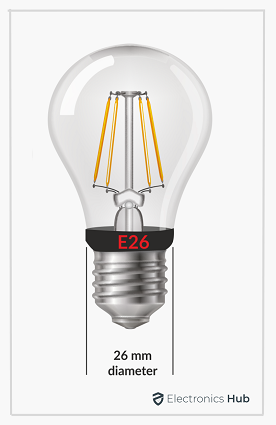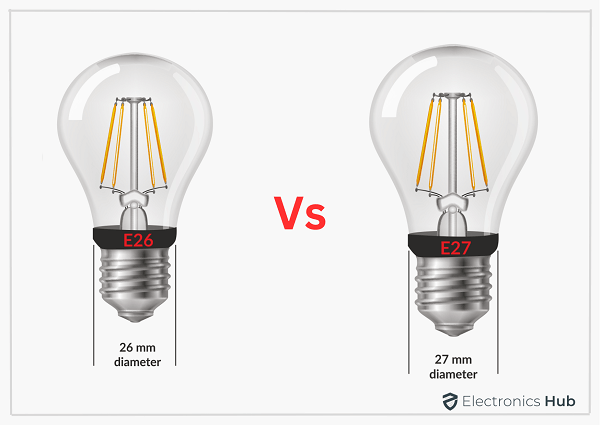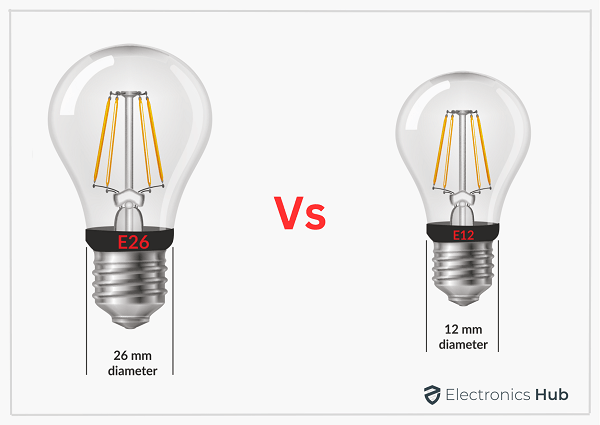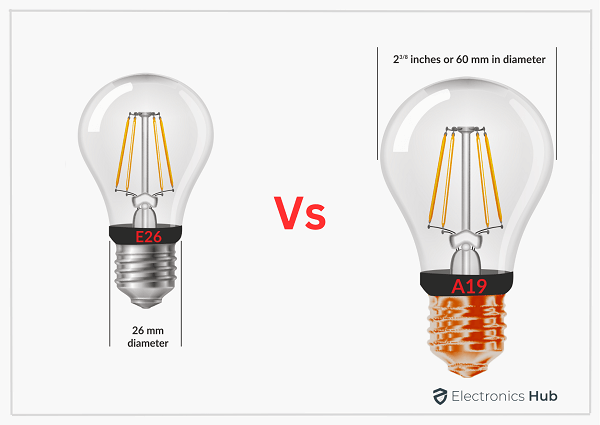Even though there are various bulbs sizes out there as you will see down below, the E26 bulb size is one of the most common ones used in American homes. And if you’re not familiar with the same, this guide is just perfect for learning about the same. By going down below, you can learn all the information about the E26 bulb socket. You can even learn about the differences between E26 and other bulb sizes in this guide so that you can easily pick the ideal bulbs for your home.
What Does the E in E26 stand for?
Before anything else, let’s break down the E26 bulb naming scheme and look at each letter one by one. Starting with the “E” present in the E26 bulb type name, the E simply means that these types of bulbs use the Edison Screw mounting method. This mounting mechanism is named Edison Screw since it is named after Thomas Edison. In fact, the letter “E” can be found in multiple popular bulb types which all use the Edison Screw mounting mechanism.
What Does the 26 in E26 stand for?
Coming to the number, “26” present in the E26 naming scheme, simply tells you about the diameter of the bulb base. This is due to the fact that E26 bulb bases have a diameter of exactly 26 mm. However, it is to be noted that this is the diameter of just the bulb base since the diameter of the complete bulb will be much larger.
What Exactly is an E26 Bulb?
Now that you better understand the E26 bulb type’s naming scheme, let’s learn more about it in detail. Talking about the obvious right away, the E26 bulb type tells you only about the bulb base and not the complete bulb unit. This means that while different E26 bulbs may look different, they all will have exactly the same base which will all be fully compatible with E26 bulb sockets. Because E26 bulbs are highly common, they are also known as a medium or standard base in the USA. Some people may also refer to them as MES or Medium Edison Screw bulbs. You can easily identify most E26 bulbs without checking their specifications. All E26 bulbs will have a metal screw based at the bottom where the diameter of this base will be approximately 1 inch. However, there is much more to consider while picking an E26 bulb as you will see later on in this guide.
E26 Bulbs and their Advantages
As mentioned earlier, E26 bulb types are highly popular in the US because of the reason that they offer various advantages. For starters, the biggest advantage is that they are highly popular which means that an E26 bulb can be used in all kinds of places. Second, since E26 bulbs use the Edison Screw for their mounting mechanism, taking an E26 bulb on and off is quite simple and fast. Despite being highly easy to install and uninstall, the screw mounting mechanism also keeps the bulb highly stable and prevents any shaking. This is due to the tight fit offered by E26 bases and sockets which not only ensures a tight fit but also prevents any damage to the electrical contacts from external factors.
Ideal Applications of E26 Bulbs
Because of the various handy advantages offered by the E26 bulb type, there are various applications for the E26 bulb type. Starting with the common geographical locations around the world, E26 bulbs are not only used in the United States but also in other North American countries as well as Japan. While E26 bulbs were primarily used in incandescent lamps, they are not used with CFL lamps, LED lamps, and even smart bulb lamps as you will learn later on.
What is Considered a Standard Sized Bulb?
If you’re in the market to buy a few new bulbs, then you may find yourself looking for a standard-sized bulb. And in case you’re not familiar with common bulb types, this can confuse you quite a lot. Thankfully, if you’re in the USA, then you will be glad to know that the E26 bulb type is considered the standard-size bulb. This is due to the fact that it uses the MES or Medium Edison Screw base.
Light Bulb Base Sizes Different Light Bulb Sizes
While there are also other Edison Screw base bulb types like E39, E12, and E17, it is the E26 bulb that offers a balance between them in terms of size. More importantly, because of the wide applications of E26 bulbs, it is considered a standard-sized bulb.
Can you Call an E26 Bulb a Standard-Sized Bulb?
As mentioned earlier, yes, an E26 bulb can be considered a standard-size bulb. But now, let’s also learn about the reasoning behind the same. The E26 bulb size is regulated by ANSI or the American National Standards Institute. When compared to most other bulb types, E26 type bulbs, most home appliances like lamps and light fixtures, are the easiest. More importantly, E26 bulbs come in almost all shapes and sizes while having the same socket type which allows you to install all kinds of lights into a single socket. Whether you want an incandescent bulb, vintage bulb, globe bulb, smart bulb, candle bulb, sphere bulb, or anything else, you can definitely find an E26 version of the same with ease.
Things to Consider Before Buying an E26 Bulb
Since the E26 bulb type is the most commonly used size here in the United States, you might also have to buy one for your home. In that case, it is highly important to ensure that you’re going with the perfect E26 bulb in terms of its functionality and not just compatibility. In fact, even when it comes to compatibility, you can find bulbs on the market that can look very similar. For example, an E27 bulb can technically fit inside an E26 socket and offer a lower price at the same time. However, an imported E27 bulb won’t have the safety certifications from ANSI or UL like an E26 bulb. Similarly, there are also other differences between E26 and other bulb types that you need to consider:
1. Differences Between E26 and E27 Bulb Sizes
Just as you can guess by the name, an E26 bulb base has a diameter of 26 mm and an E27 bulb base has a diameter of 27 mm. However, despite having a difference of 1 mm in the diameter of their bases, they look very similar in real life. And while you can work with each other’s corresponding sockets, it is recommended not to do so. As mentioned earlier, you should go with the bulb type that offers the safety certifications for your country. In short, if you’re living in the US, then you should prefer going with the E26 bulb socket.
2. Differences Between E26 and E12 Bulb Sizes
Another popular bulb type that you can find in the US markets is the E12 bulb type. Unlike the E26 bulb type, the E12 bulb base has a diameter of 12 mm which is much smaller than an E26. That being said, since this bulb type also uses the Edison Screw base mechanism, they are easy to use. But because the E12 bulb size is much smaller, it is primarily used for decorative lighting purposes.
3. Differences Between E26 and A19 Bulb Sizes
While buying an E26 bulb, you will also find a lot of A19 bulbs in the market which makes them a viable option for many. Although, these are actually not related to each other since a single bulb can be an E26 bulb and an A19 bulb type at the same time. This is due to the reason that while the E26 bulb type rating tells you about the base of the bulb, the A19 bulb type rating tells you more about the shape of your bulb. An A19 bulb simply means that the bulb is of the “A” shape which is considered to look like an upside pear. And coming to “19”, it is the diameter of the bulb’s widest part which happens to be 19 eighths of an inch which equals to be 2⅜ inches or 60 mm in diameter. Thus, if you have a bulb that is both A19 and E26 types, then it will have 60 mm as its maximum diameter along with a base diameter of 26 mm.
How Bright is an E26 Bulb?
Apart from picking the right bulb type in terms of its compatibility with a given light socket, your bulb also needs to be bright enough if you wish to use it at your home. While you can always check the brightness rating in lumens, that can be a bit confusing. To avoid this confusion, all bulbs mention their brightness in terms of their power. It can include ratings like 30 watts, 50 watts, 80 watts, and even higher. And as you would expect, going with a high wattage like 80 watts will result in quite a bright bulb for most cases.
Smart Bulbs and E26 Bulb Size
These days, it is quite common to go with a smart bulb over a standard bulb. In fact, almost all smart bulbs available out there use the E26 bulb size so that you can use them pretty much anywhere with ease. These smart bulbs can be quite practical and versatile as compared to standard bulbs. For starters, you can control them using smart assistants like Google Assistant and Alexa. By using such a smart assistant, you can change things like the power toggle, brightness, color temperature, and even color in some cases. Another benefit of using smart bulbs is that you can set up automated commands like timers and connections with other events.
Reasons to Pick an E26 Bulb
To sum up the importance of the E26 bulb type and why it is considered the standard E26 bulb type, here are some primary reasons to pick an E26 bulb:
Highly versatile bulb size which can be used with most bulb sockets found in homes and offices across the United States Easy and quick installation thanks to the inclusion of Edison Screw mounting mechanism Wide range of bulb sizes to pick from all shapes and sizes Cross-compatible with other similar bulb sizes like E27 Available in smart bulb options as well for more versatile lighting options
Conclusion
Till now, we have already discussed pretty much every detail regarding E26 bulb types. And by now, you must be able to easily choose the perfect bulb size as well as bulb type for your home lighting needs. In this detailed guide about E26 bulb types, we have covered the basic information, benefits of E26 bulbs, differences between E26 and other bulb types, and quite a lot more. So, if this guide has helped you in picking the best possible bulbs for your home, make sure to leave your thoughts and doubts in the comments section down below. Comment * Name * Email * Website
Δ









![]()